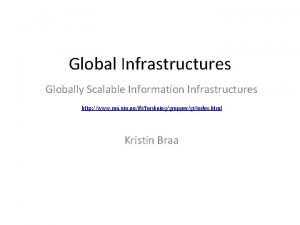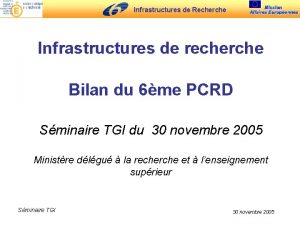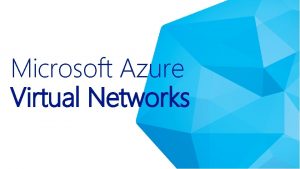VINCI Virtual Intelligent Networks for Computing Infrastructures An




























- Slides: 28

VINCI: Virtual Intelligent Networks for Computing Infrastructures An Integrated Network Services System to Control and Optimize Workflows in Distributed Systems CHEP February 2006 Harvey Newman and Iosif Legrand California Institute of Technology 1

OUTLINE u Introduction u The Mon. ALISA framework è Monitoring è Support for distributed services and Agents u The VINCI architecture u Main Services è End System Agent (LISA) è Discovery & AAA è Control of Optical planes è Interfaces with GMPLS, MLPS, SNMP … u Prediction, Learning and Self Organization 2

The Need for Network Services Ø The main objective of the VINCI project is to enable users’ applications, at the LHC and in other fields of dataintensive science, to effectively use and coordinate network resources Ø VINCI dynamically estimates and monitors the achievable performance along a set of candidate (shared or dedicated) network paths, and correlates these results with the CPU power and storage available at various sites, to generate optimized workflows for grid tasks Ø This should significantly improve the overall performance and reduce the effective costs of global-scale grids Ø The VINCI system is implemented as a dynamic set of collaborating Agents in the Mon. ALISA framework, exploiting Mon. ALISA’s ability to access and analyze in-depth monitoring information from a large number of network links and grid sites in real-time 3

VINCI: A Multi-Agent System Ø VINCI and the underlying Mon. ALISA framework use a system of autonomous agents to support a wide range of dynamic services Ø Agents in the Mon. ALISA servers self-organize and collaborate with each other to manage access to distributed resources, to make effective decisions in planning workflow, to respond to problems that affect multiple sites, or to carry out other globally-distributed tasks Ø Agents running on end-users’ desktops or clusters detect and adapt to their local environment so they can function properly. They locate and receive real-time information from a variety of Mon. ALISA services, aggregate and present results to users, or feed information to higher level services Ø Agents with built-in “intelligence” are required to engage in negotiations (for network resources, for example), and to make pro-active run-time decisions, while responding to changes in the environment 4

Mon. ALISA : An Agent-based System of Distributed Services Fully Distributed System with no Single Point of Failure Clients , HL services, repositories Proxies AGENTS Mon. ALISA services 5 Global Services or Clients Dynamic load balancing Scalability & Replication Security AAA for Clients Distributed System for gathering and Analyzing Information. Distributed Dynamic Network of JINI Discovery- based on Lookup Services; a lease Mechanism [Secure, & Public]

Monitoring OSG: Resources, Jobs & Accounting Running Jobs OSG Example: 42 SITES ~ 4, 000 Nodes (10, 000 CPUs) Thousands of Jobs 60, 000 parameters 6 Accounting

FTP Data Transfers Among Grid Sites Total FTP Traffic per VO 7

Monitoring the Abilene Backbone Network u Test for a Land Speed Record u ~ 7 Gb/s in a single TCP stream from Geneva to Caltech 8

The Ultra. Light Network BNL ESnet IN/OUT WAN Traffic 9

Available Bandwidth Measurements Embedded Pathload module. 10

Coordination Service for Available Bandwidth Measurements u u u Enforces measurement fairness Avoids multiple probes on shared network segments Dynamic configuration of measurement timing Logs events Provides service redundancy by using a master-slave model 11

Monitoring Network Topology, Latency, Routers NETWORKS ROUTERS AS Real Time Topology Discovery & Display 12

Monitoring the Execution of Jobs and their Time Evolution SPLIT JOBS LIFELINES for JOBS Summit a Job Job DAG 13 Job 1 Job 2 Job 31 Job 32

Bandwidth Challenge at SC 2005 151 Gbps Peak 475 TB Total in < 24 h 14

Monitoring VRVS Reflectors and Communication Topology Real Time Topology Discovery and Optimization 15

Communities using Mon. ALISA Major Communities q OSG Mon. ALISA Today ABILENE Demonstrated at: q CMS Running 24 X 7 q ALICE v SC 2003 at 250 Sites q D 0 Ø Collecting 250, 000 v Telecom q STAR CMS-DC 04 World parameters in near q VRVS 2003 real-time q LGC RUSSIA GRID 3 v WSIS 2003 q SE Europe GRID Ø Update rate of q APAC Grid 25, 000 parameter v SC 2004 q UNAM Grid (Mx) updates. VRVS per second q ABILENE v Internet 2 2005 q ULTRALIGHT q GLORIAD q LHC Net q Ro. Edu. NET 16 Ø Monitoring Ø 12, 000 computers Ø > 100 WAN Links Ø Thousands of Grid jobs running concurrently ALICE v TERENA 2005 v IGrid 2005 v SC 2005

The Functionality of the VINCI System ML proxy services Mon. ALISA ML Agent ML Agent Layer 3 ROUTERS Agent ETHERNET LAN-PHY or WAN-PHY DWDM FIBER Layer 2 Agent Layer 1 Agent Site A 17 Site B Site C

The Main VINCI Services Application End User Agent Authentication, Authorization, Accounting Scheduling ; Dynamic Path Allocation Failure Detection Topology Discovery GMPLS OS SNMP Control Path Provisioning MONITORING 18 System Evaluation & Optimization Prediction Learning

End User / Client Agent v v LISA- Localhost Information Service Agent Authorization Service discovery Local detection of the hardware and software configuration Complete end-system monitoring: Per-process load, Disk Storage and I/O, per-port network throughputs, etc. v End-to-end performance measurements Æ Acts as an active listener for all events related to the requests generated by its local applications CPU Memory Disk System Network 19

Secure Service Discovery and AAA Service Registration and Discovery We use JINI Lookup Services to provide a reliable mechanism to dynamically register services, and their dynamic sets of attributes Authentication, Authorization and Accounting for Users We use external AAA services supported by different Virtual Organizations. Loadable plug-in interface modules to support different protocols and services will provide the necessary flexibility to work with different grids and networks 20

Topology Discovery Using Specialized Agents u Specialized agents are used to (1) discover the connection topology for each service (2) keep a dynamic map of how they are allocated & used, and (3) get information on the traffic on each segment. u Agents running on multiple Mon. ALISA services in parallel provide the basic information to the scheduling system u These agents draw on information from MPLS/GMPLS /DRAGON/Optical Path agents, where the infrastructure provides this functionality 21

Targeted Capabilities for Topology Discovery & Path Selection Examples of Capabilities: u Determine which path-options exist between two locations in the network u List components in the path that are “manageable” u Locate network resources and services which have agreements with a given VO u Given two replicas of a data source, “discover” (in conjunction with monitoring) the estimated bandwidth and reliability, and hence the “estimated time of successful delivery” of each to a given destination. 22

Monitoring and Controlling Optical Planes Controlling Port power monitoring 23 Glimmerglass Switch Example

Agents to Create on Demand an Optical Path or Tree Discovery & Secure Connection 2 ML Demon Optical Switch 1 Control & Monitor the switch ML Agent Mon. ALISA Optical Switch ML Agent 3 The time to create a path on demand is less than 1 s independent of the location and the number of connections Mon. ALISA Runs a ML Demon ML Agent >ml_path IP 1 IP 4 Mon. ALISA “copy file IP 4” ML proxy services used in Agent Communication 24 4

A Real-World Working Example: Agents Create an Optical Path on Demand Dynamic restoration of lightpath if a segment has problems 25

The Workflow Scheduler v v v Scheduler is implemented as a set of collaborating agents Ø It provides complete autonomy to each provider of resources, who can implement his own policy Ø There is no single point of failure “Market Model” Scheduling Scheme Each agent uses policy-based priority queues; it negotiates for an end-to-end connection using a set of cost functions A lease mechanism is implemented for each offer an agent accepts from its peers Two phase commit and periodic lease renewal are used for all agents; this allows a flexible response of the agents to task completion, as well as to application failure or network errors If network errors are detected, supervising agents cause all segments to be released along a path An alternative path then may be set up: rapidly enough to avoid a TCP 26 timeout, so that the transfer can continue uninterrupted

Learning and Prediction v Learning algorithms (e. g. Self Organizing Neural Networks) will be used to evaluate the traffic created by other applications, to identify major patterns, and dynamically setup effective connectivity maps v It is very difficult if not impossible to assume that we could predict all possible events in a complex environment like a grid in advance v Heuristic learning is thus the only practical approach, where agents can acquire the necessary information to describe their environments v The multi-agent learning task includes two levels: Æ the local level of individual learning agents Æ the global level, exploiting inter-agent communication v We need to ensure that each agent can learn to optimize its actions locally, while the global monitoring mechanism acts as a ‘driving force’ that causes the agents’ behavior to evolve collectively, based on the accumulated experience 28

Mumbai-Japan-US Links 29
 Conventional computing and intelligent computing
Conventional computing and intelligent computing Virtual circuit network
Virtual circuit network European strategy forum on research infrastructures
European strategy forum on research infrastructures Leonardo de vinci was born on april 15
Leonardo de vinci was born on april 15 Violante di ser piero da vinci
Violante di ser piero da vinci Leonardo da vinci was born on april 15 1452
Leonardo da vinci was born on april 15 1452 Backbone networks in computer networks
Backbone networks in computer networks Collaborating via social networks and groupware
Collaborating via social networks and groupware Has virtual functions and accessible non-virtual destructor
Has virtual functions and accessible non-virtual destructor Mall debattartikel
Mall debattartikel Kung dog 1611
Kung dog 1611 Tack för att ni lyssnade
Tack för att ni lyssnade Tobinskatten för och nackdelar
Tobinskatten för och nackdelar Vad är referatmarkeringar
Vad är referatmarkeringar Tack för att ni har lyssnat
Tack för att ni har lyssnat Lågenergihus nyproduktion
Lågenergihus nyproduktion Karttecken
Karttecken Var finns arvsanlagen
Var finns arvsanlagen Varför kallas perioden 1918-1939 för mellankrigstiden?
Varför kallas perioden 1918-1939 för mellankrigstiden? Rbk-mätning
Rbk-mätning Tryck formel
Tryck formel Förklara densitet för barn
Förklara densitet för barn Elektronik för barn
Elektronik för barn Tack för att ni har lyssnat
Tack för att ni har lyssnat Smärtskolan kunskap för livet
Smärtskolan kunskap för livet Jiddisch
Jiddisch Novell typiska drag
Novell typiska drag Fimbrietratt
Fimbrietratt Trög för kemist
Trög för kemist




















































